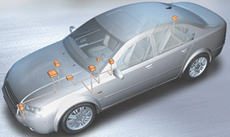CAN Bus System
- Standard CAN (Version 2.0A)
- Uses 11 bit identifiers
- Bus transfers information to and from all locations
- All controllers send and receive information on bus
- All sensors send information on bus
- All actuators/ replays are activated by signals from bus
Advantage of this System
- The bus is a 2-wire interface running over a Shielded Twisted Pair (STP) cable
- Can handle multiple controllers
- Higher priority message is guaranteed to gain bus access as if it were the only message being transmitted
- Lower priority messages are automatically re-transmitted in the next bus cycle, or in a subsequent bus cycle if there are still other, higher priority messages waiting to be sent
- Before sending a message the CAN node checks if the bus is busy
- It also uses collision detection to determine if a message has been altered
- The content of the message is labeled by an identifier that is unique throughout the network. All other nodes on the network receive the message and each performs an acceptance test on the identifier to determine if the message, and thus its content, is relevant to that particular node
- If the message is relevant, it will be processed; otherwise it is ignored
- Messages are transmitted over CAN low and high wires through 2 to 5 volts
- The error is detected by the a CAN controller (a transmitter or a receiver)
- Transmitters re-read message after it has been sent
- Receivers can tell if message doesn’t make sense
- An error frame is immediately transmitted. The message is cancelled at all nodes
- The status of the CAN controllers are updated
- The message is re-transmitted. If several controllers have messages to send, normal arbitration is used
|
| |
 |
| |
Automotive Communication |
| |
|
| |
 |
| |
Networking |
|